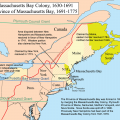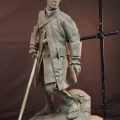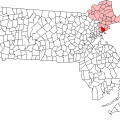( – promoted by navajo)

photo credit: Aaron Huey |
In Massachusetts, the Puritan approach to bringing Christianity to the Indians focused on segregation. Indians would be segregated into their own Christian villages, known as praying towns, where they would acquire both Christian faith and English culture. One of the first praying towns was Natick.
In 1651, Puritan missionary John Eliot received 2,000 acres of land so that Christian Indians could build an English-style town. The site straddled the Charles River 18 miles upriver from Boston. Waban, the leader of the Massachusett village of Nonantum, made the request for the creation of the Christian village.
The new town was to replicate an English cultural landscape and included an English-style meetinghouse, fort, and arched footbridge across the river. While the Indians had traditionally lived in extended family units, the lots for houses were laid out for nuclear families. In spite of the design, most of the Indians erected traditional wigwams rather than English clapboard.
The Christian Indian converts in Natick had to wear their hair in the English style which meant that the men had to have their traditional braids shorn. In order to demonstrate their ability to walk the Christian path, the Indian converts had to give up such things as body greasing and participation in traditional community ceremonies. The Natick Indians adopted a legal code based on a biblical prototype which outlawed many traditional practices, including premarital sex, long hair, and cracking lice between the teeth. In general the great personal freedom which had been enjoyed by the Indians had to be surrendered for new standards of piety that stipulated fines and flogging if they broke the rules.
Natick, whose name means “the place of seeking,” was a sacred place and had been used for vision quests and dances. The location for this praying town was probably not chosen by the Puritans who were most likely unaware of its traditional sacredness, but rather it was chosen by the pauwaus (traditional spiritual leaders) who wanted to incorporate some of the Christian power into the Indian ways.
Waban, the Massachusetts leader who had requested the foundation of Natick, was less than enthusiastic about Christianity. However, he was afraid that the English would kill him if he didn’t pretend to embrace their religion. In addition, the English provided him with good food.
The Puritan approach to converting the Indians focused on their learning the Gospel. Thus, the missionary John Elliot translated the Bible and other religious works into the Massachusett language. He then distributed these to his converts. By 1660, Elliot claimed that 100 of his converts in Natick were literate.
While the Indians in the praying towns were doing their best to shed their Indian-ness and to become English, the English colonists did not trust them. When King Philip’s War broke out in 1675, the praying villages declared their neutrality. The English colonists confined all of the “friendly” Indians to a few of the eastern praying towns, The colonists then confiscated the crops and tools in the praying towns of Wamesit, Hassanamisset, Magunkaquag, and Chabanakongkomun. The Indians were confined to the village limits on penalty of death.
In spite of the pledges of neutrality and declarations of their friendly feelings toward the English, the colonists continued to accuse the Christian Indians of supporting King Philip. The residents of Okommakamesit were arrested and marched to jail in Boston. The Natick were forced from their homes and interred on Deer Island in Boston Harbor. Deer Island was a windswept rock with little fuel and little shelter from the cold sea wind. In spite of the English hostility, the Christian Indians continued to declare their loyalty to the English and about 100 Indian men enlisted in the colonial army as scouts.
In 1677, the General Court ordered that all Indians be settled in four praying towns: Natick, Punkapoag, Hassanamesit, and Wamesit. The Indians in these towns were prohibited from entertaining “stranger” Indians and the Court ordered that a list of all inhabitants of the praying towns be made annually. When leaving the towns, the Indians were required to have a magistrate’s certificate proving their loyalty. When approached by an English person, the Indians were to lay their guns on the ground until the English had examined their papers.
The English obsession with private land ownership created a number of conflicts with the Indians in the praying towns. In 1680, for example, an English farmer bought 50 acres from two Indians in the Christian Indian village of Natick. The sale was without the consent of the town council and in violation of colonial law. The Englishman then altered the deed to 500 acres. The village then sued, won, and recovered 400 acres. Keep in mind, however, that the farmer only bought 50 acres originally and therefore managed to cheat the Indians out of an additional 50 acres.
In 1698, the English town of Dedham stole 1,400 acres from the bordering Christian Indian town of Natick. The stolen land included orchards and corn fields.
In 1715, the New England Company asked the Natick to sell them the apparently abandoned praying town of Magunkaquog. The Company proposed to rent out the land to English settlers and share the rent money with the Natick families. The Natick, however, were still growing crops in the area and have deep emotional feelings about the area. Magunkaquog means the “place of the giant trees” in reference to the great trees – oak and chestnut – which were found in abundance in the area.
After initially rejecting the offer, the Natick agreed to the deal. After signing the deed, one of the signatories, Isaac Nehemiah, committed suicide by hanging himself with his belt. This suicide highlighted how some Indians ‘passively’ resisted the sale of their lands to colonists. It also showed the emotional attachment that many Natick Indians still held to Magunkaquog.
In 1719, the Natick created a proprietorship – a corporate entity to govern land allotments. The 20 proprietors – 19 men and one woman – were the heads of long established families. The proprietorship provided secure land titles and boundaries under colonial law which were seen as useful in meeting outside pressures. This change in administration, however, severed landholding from the town political system. It brought the Native community closer to the form of the English legal and economic systems.
During the Revolutionary War, Christian Indian soldiers served in the Continental Army and saw service in the Battles of Lexington and Bunker Hill. Following the Revolutionary War and the creation of the United States, the covenants between the Indians in the praying towns, such as Natick, and the colonists was dissolved. Natick was incorporated in 1781, thus losing its special status as an Indian town. By 1785 most of the Indians had left Natick. Many of the praying Indians in New England migrated west, hoping to find a place where they could be both Christian and Indian.




Leave a Reply